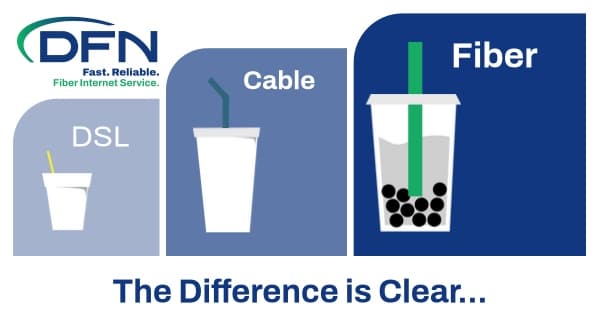Now more than ever, a reliable internet connection is essential for work, education, entertainment, and staying connected with loved ones. With various internet technologies available, understanding the differences between them allows you to make an informed choice for your connectivity needs. Let’s compare fiber optic, DSL, and satellite internet technologies to demonstrate why fiber optic is the best choice for your home, and why it’s considered “future proof.”
DSL Internet Technology
DSL uses existing copper telephone lines to deliver internet service with an electrical pulse. While it can provide decent speeds—typically ranging from 1 to 100 Mbps—its performance is usually inhibited by the distance from the provider’s central office.
DSL technology has several limitations that can impact user experience. One major concern is distance sensitivity; the further you are from the provider’s infrastructure, the weaker your signal and slower your speeds will be, leading to inconsistent performance, particularly in rural areas. Additionally, many DSL plans feature asymmetrical speeds, often providing higher download speeds than upload speeds, which can be limiting for users who need to upload large files or participate in video calls. Lastly, DSL connections can be susceptible to interference from noise and other disruptions on the phone line, potentially disrupting your internet service.
Satellite Internet Technology
Satellite internet connects users through satellites orbiting the Earth, sending signals to and from a dish installed at the user’s location. This technology is often used in rural and remote areas where other options are limited.
Satellite internet comes with several limitations that can affect user experience. One significant issue is high latency; because satellite connections rely on signals traveling to space and back, they often experience delays that make them less suitable for real-time applications like gaming or video conferencing. Additionally, satellite signals are vulnerable to weather conditions; rain, snow, and other adverse weather can disrupt connectivity and impact reliability. Moreover, many satellite providers impose data caps, limiting the amount of data users can consume each month. Exceeding these caps can lead to throttled speeds or additional fees, further complicating the internet experience for users.
Fiber Optic Internet Technology
Fiber optic technology uses thin strands of glass or plastic (fibers) to transmit data as pulses of light. This method allows for incredibly high-speed internet access with minimal signal loss over long distances. Fiber optic connections can offer speeds ranging from 100 Mbps to several Gbps (gigabits per second).
Why Fiber is the Best Technology Available:
- Speed: Fiber optic internet offers the fastest speeds available, making it ideal for high-bandwidth activities like streaming, gaming, and video conferencing. With symmetrical upload and download speeds, users can enjoy seamless online experiences.
- Reliability: Fiber optics are less susceptible to interference and environmental factors compared to other technologies. This results in a more stable connection, reducing downtime and maintaining performance even during peak usage hours.
- Capacity: Fiber networks can handle significantly more data at once than DSL or satellite technologies. This means more users can connect simultaneously without a noticeable drop in speed.
- Future Proofing: As technology advances and data consumption continues to grow, fiber optic networks can be easily upgraded to accommodate higher speeds and increased bandwidth without needing major infrastructure changes.
Fiber optic technology is considered “future proof” for several reasons. First, its scalability allows for upgrades to faster speeds without requiring extensive rewiring or significant infrastructure changes, enabling fiber networks to adapt to the growing demands of internet usage. Additionally, with the rise of technologies like 5G and advancements in streaming and virtual reality, the need for high-speed, high-capacity internet is expected to increase significantly. Fiber’s ability to handle large amounts of data ensures that it remains a relevant choice in an ever-evolving digital landscape. Furthermore, as smart homes and IoT (Internet of Things) devices become increasingly prevalent, the demand for fast and reliable internet will continue to rise, making fiber’s robust capacity the ideal solution to support these emerging technologies.
While DSL and satellite internet can provide basic connectivity, fiber optic technology stands out as the best option for speed, reliability, and future adaptability. As our digital world continues to evolve, investing in fiber optic internet is not just a choice for today but a commitment to a connected future. For anyone looking to ensure a fast, reliable, and future-proof internet experience, DFN can connect you with fast, reliable fiber internet that fits your lifestyle and budget. Contact us today to learn more, and follow our social pages for more technology news!
